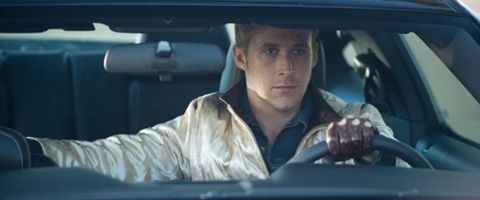Drive is like a high-octane eighties action-racing flick done in the style of European films that are about long pauses and arranging matches. Is that a good thing? Well, sort of... Like many classic cinematic men with no name, Ryan Gosling is just known as the Driver. He works in a Los Angeles garage by day, occasionally does work as a movie stunt driver, and moonlights as a top getaway driver for anyone who’ll meet his price and his rules. There’s nothing else in his life until a chance encounter lets him spend more time with his neighbor Irene (Carey Mulligan) and her son (Kaden Leos), and a wonderfully chaste romance begins between the two of them. And this is all good until Irene’s husband, Standard (Oscar Isaac), is released from prison and comes home to meet the quiet man who’s been “taking care of things” for his wife.
In most films, this would be the main conflict and it’d be a standard love triangle. But while Standard isn’t a saint, he also isn’t an unreasoning monster. In fact, the real problem is that some trouble’s followed Standard home from prison, and even though he wants to go straight it’s a lot more than he can deal with. So the Driver steps in with his unique services to help Standard pay his debts and live a good life with Irene. When the job goes horribly wrong, though, he comes to realize just how deep in trouble he is—and how much danger Irene’s in.
I’ve got to be honest. When I first started seeing ads for Drive it just struck me as a thinly-veiled remake of The Transporter. While there’s a decent number of similarities between the films and their lead characters, they’re two remarkably different movies. And that difference is all in the execution.
Drive is an action movie that’s been done as an indie art film. That may sound a little odd and off-putting to some folks, but in many ways it makes for a fascinating film. From its opening cat-and-mouse “chase” scene to many of the long, quiet, almost self-indulgent moments between the Driver and Irene, the very minimalist film makes it clear that the characters are going to be far more of the focus than anything the characters do.
Which isn’t to say there isn’t a strong action element. That opening scene I just mentioned is brilliant, as is a later chase through the desolate areas of northern Los Angeles. There’s a few scenes of gore and hardcore brutality that will stick with you for long after the end credits. But they are scattered through the film, and there’s never a point when the tension is really cranking up and keeping you on the edge of your seat.
Alas, some of these quiet scenes drag on just a little too long, and when the audience gets too much time to think about stuff they start asking questions. Where the heck did the Driver come from that he’s got all these specialized survival skills? How much of a set-up was Standard’s last heist? Is it just a coincidence that so many things tie back to stock car-investor Bernie (Albert Brooks) and his partner Nino (Ron Perlman)? For such a plot-heavy film, director Nicolas Windig Refn really doesn’t spend much time or effort focused on the story.
And this is where my criticism of the movie comes from. While there’s a lot of beautiful character moments, phenomenal action, and gorgeous cinematography, I’m not really sure they create a coherent film. It’s fascinating and absorbing, I enjoyed watching it, and I think most people who enjoy movies should see it--but I’m still not sure if I actually liked the movie itself. It’s more like a collection of fantastic scenes that almost make a fantastic film, but never line up quite right. We got the DVD of Drive, not the Blu-Ray, but they come with all the same special features (except the UltraViolet digital copy). There’s no commentary track, but there are a bunch of previews and a handful of six to seven minute featurettes, and most of them feel a bit padded even at that.
“I Drive” is mostly interviews with the producers, and Adam Siegel lists all the ways Drive is just like The Transporter while refusing to acknowledge that franchise’s existence. “Under the Hood” focuses more on screenwriter Hossein Amini and his adaptation of James Sallis’s novel. “Driver and Irene” is some bits from the lovely Carey Mulligan about the almost-relationship between the two leads. “Cut to the Chase” looks at some of the clever driving shots and stunt moments in the film.
“Drive Without a Driver” is a the longest of the features, an extended interview with director Refn about how the movie came to be and how he put his own spin on it to make it (his words) “a fetish film.” There’s a funny story about his first meeting with Gosling and some anecdotes about selecting the cast and getting financing, but overall it’s pretty tepid stuff that confirms Refn is solidly an indie director. Take that as you will.
Is Drive worth buying? I’ll leave that up to you and your personal taste. But it’s definitely worth seeing,

Dragon Ball Z's Spinoff Daima Is Officially Available In English, And I Think Fans Should Be Watching For One Major Reason

Why January And February Are Honestly The Best Times To Visit Universal Orlando And Walt Disney World

The Sweet Gifts Hoda Kotb Received From Today Co-Host Savannah Guthrie Before Her Final Day On The Job
Most Popular




